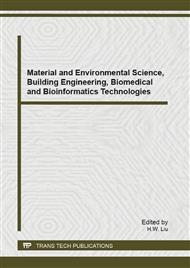[1]
Shiwei Zuo, Lixin Xie, Pingli Li. Mineralization process research of desalinated water[J]. Chemistry Industry and Engineering 2(2010)163-166.
Google Scholar
[2]
Liat Birnhack, Nikolay Voutchkov, Ori Lahav, Fundamental chemistry and engineering aspects of post-treatment processes for desalinated water[ J]. Desalination 273 (2011) 6-22.
DOI: 10.1016/j.desal.2010.11.011
Google Scholar
[3]
Stefan Platikanov, Veronica Garcia, Ignacio Fonseca, Elena Rullan, Ricard Devesa, Roma Tauler, Influence of minerals on the taste of bottled and tap water: A chemometric approach[ J]. Water Research 47 (2013) 693-7 04.
DOI: 10.1016/j.watres.2012.10.040
Google Scholar
[4]
David Hasson, Orly Bendrihem, Modeling remineralization of desalinated water by limestone dissolution[J]. Desalination 190 (2006) 189–200.
DOI: 10.1016/j.desal.2005.09.003
Google Scholar
[5]
G. Migliorini, R. Meina rdi. 40 MIGD potabilization plant at Ras Laffan: design and operating experience, Desalinatio n 182 (1– 3) (2005) 275–282.
DOI: 10.1016/j.desal.2005.03.019
Google Scholar
[6]
R. Kettunen, P. Keskitalo, Combination of membrane technology and limestone fil-tration to control drinking water quality, Desalination 131 (1–3) (2000) 271–28 3.
DOI: 10.1016/s0011-9164(00)90025-0
Google Scholar
[7]
R.D. Letterman, Calcium carbonate dissolution rate in limestone contactors. US Environmental Protec-tion Agency, Risk Reduction Engineering Labora-tory, Cincinnati, OH (Cooperative AgreementNo. CR814926). EPA/600/R-95/068, (1995).
Google Scholar
[8]
G.S. Mackintosh, P.F. De Souza, H.A. De Villiers, Design and operation guidelines for municipal sizY. Yamauchi, K. Tanaka, K. Hattori, M. Kondo, N. Ukawa, Remineralizationof desalinated water by limestone dissolution filter, Desalination 66 (1987).
DOI: 10.1016/0011-9164(87)90218-9
Google Scholar
[9]
T.F. Seacord, J.E. Singley, G. Juby, N. Voutchkov, Post treatment concepts for sea-water and brackish water desalting, AWWA Membr. Technol. Conference. March, 2-5, 2003, Atlanta, Georgia, 2003, p.1– 15.
Google Scholar
[10]
L. Birnhack, N. Voutchkov, O. Lahav, Fundamental chemistry and engineering aspects of post-treatment processes for desalinated water — a review, Desalination273 (1) (2011) 6 –22.
DOI: 10.1016/j.desal.2010.11.011
Google Scholar
[11]
C. Agatemor, P.O. Okolo, Studies of corrosion tendency of drinking water in the distribution systemat the University of Benin, Environmentalist 28 (2008) 379–384.
DOI: 10.1007/s10669-007-9152-2
Google Scholar
[12]
B.Y. Shi, J.S. Taylor, Iron and copper release in drinking-water distribution systems, J. Environ. Health 70 (2007) 29–36.
Google Scholar


